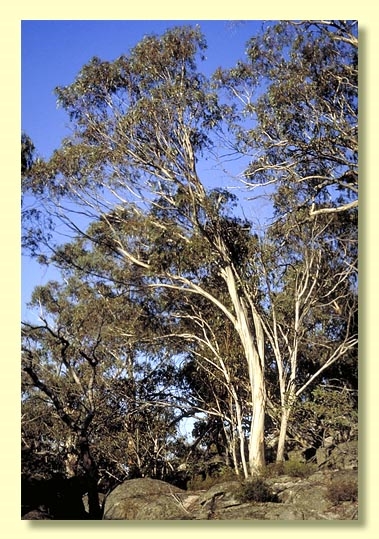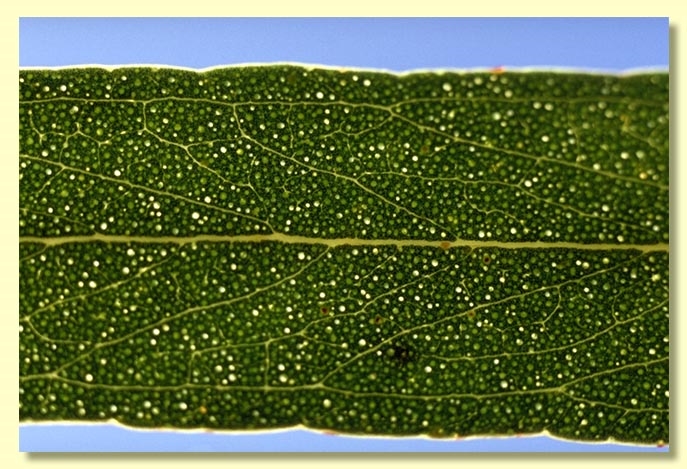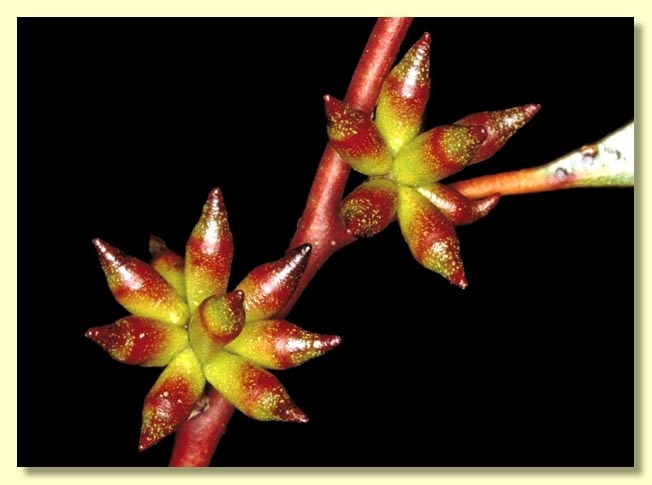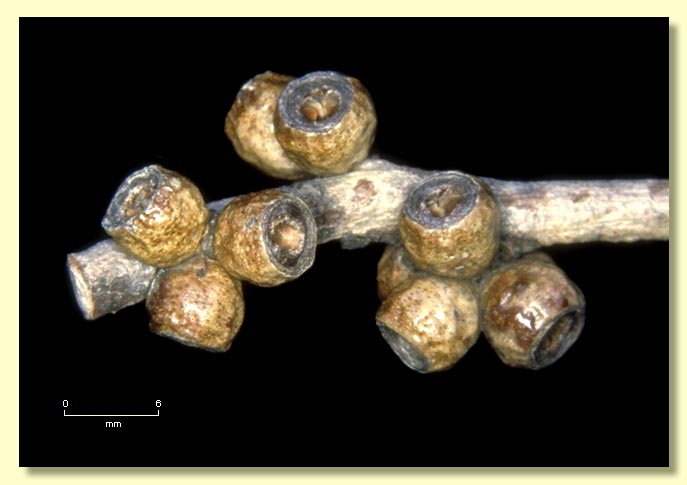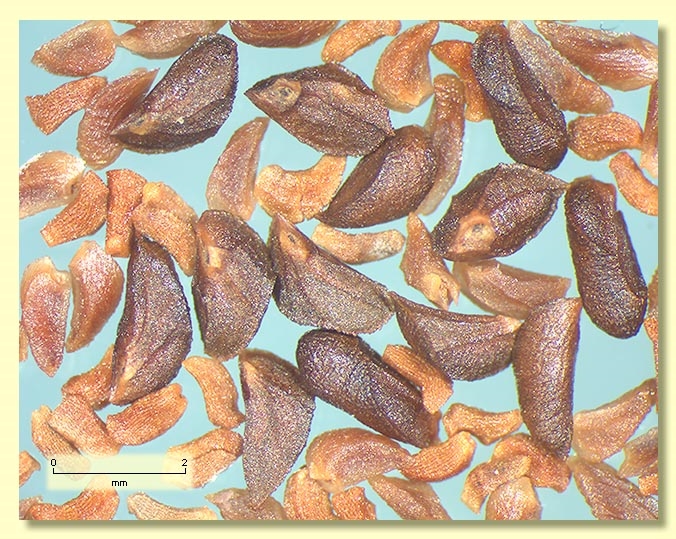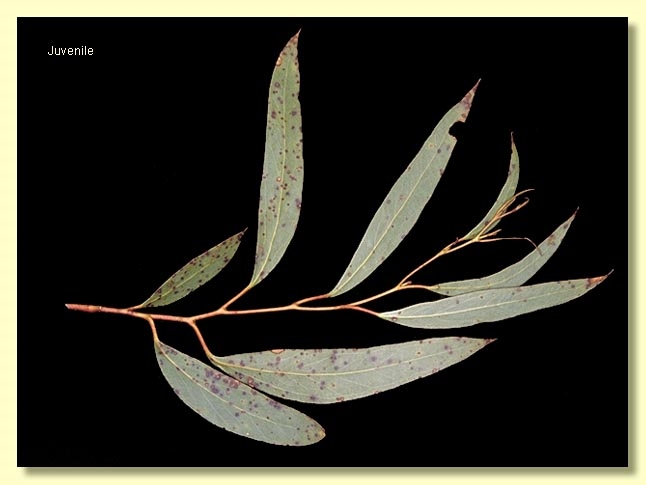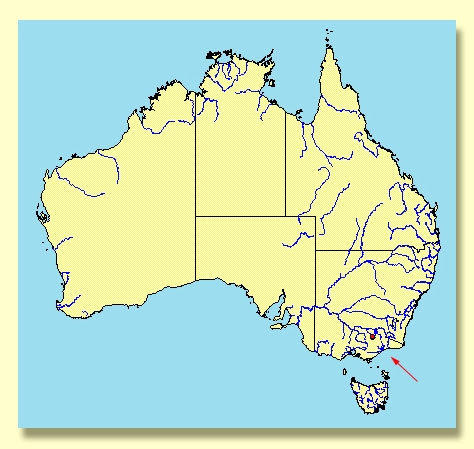Euclid - Online edition
Eucalyptus mitchelliana
Eucalyptus | Eucalyptus | Longitudinales
Eucalyptus mitchellii Cambage, op. cit. 457 (1916) nom. illeg. non Ettingsh. (1861). T: Mt Buffalo, Victoria, Jan. 1913, R.H.Cambage 3786; holo: NSW ; iso: MEL.
Eucalyptus stellulata var. alpina Ewart, Flora of Victoria: 835 (1931).
Tree or mallee to 15 m tall. Forming a lignotuber.
Bark smooth white to yellow and creamy-grey; crown ribbony at times.
Juvenile growth (coppice or field seedlings to 50 cm): stem rounded in cross-section, warty; juvenile leaves opposite, sessile and elliptical for first few pairs, then alternate, very shortly petiolate, lanceolate to falcate, 6.5–11.5 cm long, 0.9–2 cm wide, concolorous, base tapering to petiole, green to blue-green.
Adult leaves alternate, petiole 0.8–2.1 cm long; blade linear to lanceolate to falcate, 7.5–15 cm long, 0.6–2 cm wide, base tapering to petiole, margin entire, concolorous, glossy, green, side-veins acute (nearly parallel to the midrib), reticulation sparse, intramarginal vein parallel to and well removed from margin, oil glands island.
Inflorescence axillary unbranched, peduncles 0.1–0.5 cm long, buds 7, 9 or 11 per umbel, sessile in stellate clusters. Mature buds fusiform, 0.7–1 cm long, 0.3–0.4 cm wide, green to yellow, scar absent, operculum conical to horn-shaped, stamens inflexed or irregularly flexed, anthers reniform to cordate, versatile, dorsifixed, dehiscing by confluent slits (usually), style short or long, stigma tapered, locules 3 or 4, the placentae each with 2 vertical ovule rows. Flowers white.
Fruit sessile, cup-shaped to truncate-globose, 0.5–0.7 cm long, 0.5–0.7 cm wide, disc level or descending, valves 3 or 4, near rim level or enclosed.
Seeds brown or reddish brown, 1.5–2.5 mm long, pyramidal or obliquely pyramidal, dorsal surface smooth, hilum terminal.
Cultivated seedlings (measured at ca node 10): cotyledons reniform; stems rounded in cross-section; leaves shortly petiolate, opposite for 4 or 5 nodes then alternate, lanceolate, 5.5–9 cm long, 1–3 cm wide, base tapering, margin entire, apex pointed, dull, pale green.
Flowering has been recorded in November, December and January.
A small tree endemic to northern Victoria occurring only on the Mt Buffalo Plateau along the northern and north-eastern rim, and at the Back Wall south of the Horn. It has smooth white and grey bark, a glossy green crown with acute side-veins (almost parallel to the midrib) in the leaves, sessile fusiform buds and small squat fruit.
Eucalyptus mitchelliana grows with snow gums, E. pauciflora, which differs in having adult leaves with side-veins parallel to the midrib, obovoid buds, and larger fruit. E. mitchelliana is related to two other species with fusiform buds in stellate clusters, E. stellulata, which differs in the rough basal bark, greenish smooth bark on the upper trunk and branches and shorter, broader adult leaves with main side-veins parallel to the midrib; and the New South Wales endemic E. moorei, which differs in the low mallee habit and smaller leaves.
Eucalyptus mitchelliana belongs in Eucalyptus subgenus Eucalyptus section Longitudinales, because of the following combination of characters: tree or mallee habit, juvenile leaves opposite for several to many pairs, adult leaves with acute side-veins, single axillary inflorescences, buds sessile and fusiform in stellate clusters, with buds having only one operculum, reniform anthers and ovules in two rows, and more or less pyramidal seeds. There are only three species in section Longitudinales, E. stellulata, E. mitchelliana and E. moorei (with two subspecies), differing as outlined above.

